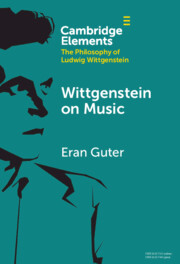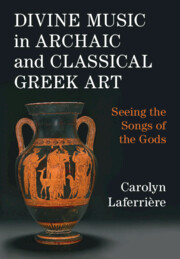371 results
15 - Artistic Witness and Response to Environmental Violence
- from Part III - Environmental Violence Impacts, Responses, Resistance, and Alternatives
-
-
- Book:
- Exploring Environmental Violence
- Print publication:
- 30 June 2024, pp 318-339
-
- Chapter
-
- You have access
- Open access
- HTML
- Export citation
4 - The B Word
-
- Book:
- Bitch
- Print publication:
- 27 June 2024, pp 98-130
-
- Chapter
- Export citation
Chapter 34 - Goethe and the Musical World
- from Part VI - Goethe’s Lasting Significance
-
-
- Book:
- Goethe in Context
- Published online:
- 16 May 2024
- Print publication:
- 23 May 2024, pp 332-340
-
- Chapter
- Export citation
Chapter 16 - Music as Sonic Literature
- from Part II - Critical Inroads
-
-
- Book:
- A History of Argentine Literature
- Published online:
- 09 May 2024
- Print publication:
- 16 May 2024, pp 245-257
-
- Chapter
- Export citation
Does experience of music enhance olfaction: music as a potential nutrition intervention?
-
- Journal:
- Proceedings of the Nutrition Society / Volume 83 / Issue OCE1 / April 2024
- Published online by Cambridge University Press:
- 07 May 2024, E78
-
- Article
-
- You have access
- Export citation
Chapter 11 - Modalities of Landscape
- from Part II - Inspiration and Expression
-
-
- Book:
- Vaughan Williams in Context
- Published online:
- 28 March 2024
- Print publication:
- 04 April 2024, pp 93-102
-
- Chapter
- Export citation
Chapter 2 - Personality
- from Part I - Biography, People, Places
-
-
- Book:
- Vaughan Williams in Context
- Published online:
- 28 March 2024
- Print publication:
- 04 April 2024, pp 19-26
-
- Chapter
- Export citation
Chapter 3 - The Sound of the Word: Music and Social Transgression in Lyric Poetry from the Colonia Onward
-
-
- Book:
- A History of Mexican Poetry
- Published online:
- 21 March 2024
- Print publication:
- 21 March 2024, pp 55-77
-
- Chapter
- Export citation

Wittgenstein on Music
-
- Published online:
- 04 March 2024
- Print publication:
- 11 April 2024
-
- Element
- Export citation
Four - Divine Music in Context
-
- Book:
- Divine Music in Archaic and Classical Greek Art
- Published online:
- 01 February 2024
- Print publication:
- 29 February 2024, pp 158-199
-
- Chapter
- Export citation
One - Sculpting Divine Music
-
- Book:
- Divine Music in Archaic and Classical Greek Art
- Published online:
- 01 February 2024
- Print publication:
- 29 February 2024, pp 30-71
-
- Chapter
- Export citation
Two - Pouring Performances
-
- Book:
- Divine Music in Archaic and Classical Greek Art
- Published online:
- 01 February 2024
- Print publication:
- 29 February 2024, pp 72-114
-
- Chapter
- Export citation
Five - Responding to Divine Music
-
- Book:
- Divine Music in Archaic and Classical Greek Art
- Published online:
- 01 February 2024
- Print publication:
- 29 February 2024, pp 200-241
-
- Chapter
- Export citation
Introduction
-
- Book:
- Divine Music in Archaic and Classical Greek Art
- Published online:
- 01 February 2024
- Print publication:
- 29 February 2024, pp 1-29
-
- Chapter
- Export citation
11 - Exempt Income and Non-Assessable Non-Exempt Income
- from Part D - Income
-
- Book:
- Foundations of Taxation Law
- Published online:
- 09 February 2024
- Print publication:
- 15 February 2024, pp 281-292
-
- Chapter
- Export citation

Divine Music in Archaic and Classical Greek Art
- Seeing the Songs of the Gods
-
- Published online:
- 01 February 2024
- Print publication:
- 29 February 2024
Egyptian Fan Culture and the Afterlife of ʿAbd al-Halim Hafiz
-
- Journal:
- International Journal of Middle East Studies / Volume 56 / Issue 1 / February 2024
- Published online by Cambridge University Press:
- 19 February 2024, pp. 1-17
- Print publication:
- February 2024
-
- Article
-
- You have access
- HTML
- Export citation
Musical convergence and divergence in occupied İstanbul, 1918–1923
-
- Journal:
- New Perspectives on Turkey , First View
- Published online by Cambridge University Press:
- 29 January 2024, pp. 1-19
-
- Article
- Export citation
Ab Initio Determination of Edge Surface Structures for Dioctahedral 2:1 Phyllosilicates: Implications for Acid-Base Reactivity
-
- Journal:
- Clays and Clay Minerals / Volume 51 / Issue 4 / August 2003
- Published online by Cambridge University Press:
- 01 January 2024, pp. 359-371
-
- Article
- Export citation
13 - African American Soundscapes
- from Part IV - Critical Approaches
-
-
- Book:
- The Cambridge Companion to Contemporary African American Literature
- Published online:
- 14 December 2023
- Print publication:
- 21 December 2023, pp 227-238
-
- Chapter
- Export citation



